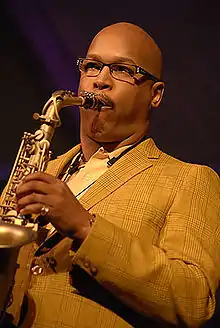Greg Osby
Greg Osby (born August 3, 1960[1]) is an American saxophonist and composer.
Greg Osby | |
|---|---|
 Osby performing in 2008 | |
| Background information | |
| Born | August 3, 1960 St. Louis, Missouri, U.S. |
| Genres | Free jazz, free funk, M-Base |
| Occupation(s) | Musician, record label owner |
| Instruments | Saxophone |
| Years active | 1980–present |
| Labels | JMT, Blue Note |
| Associated acts | Stata Institute, M-Base Collective |
| Website | www |
Biography
Born in St. Louis, Missouri, Osby studied at Howard University, then at the Berklee College of Music.[1] He moved to New York City in 1982, where he played with Jaki Byard, Jim Hall, Muhal Richard Abrams, Andrew Hill, Jack DeJohnette, Dizzy Gillespie, and Herbie Hancock.[2] In 1985, he joined DeJohnette's group Special Edition.[2] With Geri Allen, Steve Coleman, Gary Thomas, and Cassandra Wilson, he was a founding member of the M-Base Collective.[3]
Osby began recording albums under his own name for JMT Records in the mid-1980s, then signed with Blue Note in 1989.[2] In 2007, he formed his own label, Inner Circle Music.[2] He gave exposure to young pianist Jason Moran,[4] who appeared on most of Osby's 1990s albums, including Further Ado, Zero, Banned in New York and Symbols of Light, a double quartet featuring the addition of a string quartet to the band.[5]
He has also played with Phil Lesh and Friends, and he has toured with the Dead, a reincarnation of the Grateful Dead.[6] He received the Playboy Magazine Jazz Artist of the Year award for 2004 and 2009.[7]
Nate Chinen, writing for The New York Times, called Osby "a mentor and a pacesetter, one of the sturdier bridges between jazz generations," and stated that he has "a keen, focused tone on alto saxophone and a hummingbird's phrasing, an equilibrium of hover and flutter."[8]
Discography
As leader
| Title | Recorded | Released | Label | Notes |
|---|---|---|---|---|
| Greg Osby and Sound Theatre | May–June 1987 (*) | 1987 | JMT | |
| Mindgames | May 1988 | 1988 | JMT | |
| Season of Renewal | July 1989 | 1989 | JMT | |
| Man-Talk for Moderns Vol. X | October–November 1990 | 1991 | Blue Note | |
| 3-D Lifestyles | 1993 | Blue Note | ||
| Black Book | 1995 | Blue Note | ||
| Art Forum | 1996 | Blue Note | ||
| Further Ado | 1997 | Blue Note | ||
| Zero | January 1998 | 1998 | Blue Note | |
| Banned in New York | 1998 | Blue Note | Live | |
| Friendly Fire | December 1998 | 1999 | Blue Note | with Joe Lovano |
| New Directions | May 1999 | 2000 | Blue Note | with Stefon Harris, Jason Moran, Mark Shim |
| The Invisible Hand | September 1999 | 2000 | Blue Note | With Gary Thomas, Andrew Hill, Jim Hall, Scott Colley, Terri Lyne Carrington |
| Symbols of Light (A Solution) | January 2001 | 2001 | Blue Note | |
| Inner Circle | April 1999 | 2002 | Blue Note | |
| St. Louis Shoes | January 2003 | 2003 | Blue Note | |
| Public | January 2004 | 2004 | Blue Note | Live |
| Channel Three | February 2005 | 2005 | Blue Note | |
| 9 Levels | August 2008 | 2008 | Inner Circle Music |
As sideman
With Franco Ambrosetti
- Movies Too (Enja, 1988)
- Music for Symphony and Jazz Band (Enja, 1991)
With Cecil Brooks III
- The Collective (Muse, 1989)
With Uri Caine
- Cipher Syntax (JMT, 1989) as Strata Institute
- The Goldberg Variations (Winter & Winter, 2000)
With Steve Coleman
With Andrew Cyrille
- Low Blue Flame (Tum, 2006)
With Robin Eubanks
- Karma (JMT, 1991)
With Gary Thomas
- By Any Means Necessary (JMT, 1989)
- Pariah's Pariah (Winter & Winter, 1998)
With Andrew Hill
- Eternal Spirit (Blue Note, 1989)
- But Not Farewell (Blue Note, 1991)
With Jason Moran
- Soundtrack to Human Motion (Blue Note, 1999)
With Tineke Postma
- Sonic Halo (Challenge Records, 2014)
References
- Feather, Leonard; Gitler, Ira (1999). "Osby, Greg". The Biographical Encyclopedia of Jazz. New York: Oxford University Press. p. 508.
- "Greg Osby: Biography". All About Jazz. Retrieved February 22, 2022.
- Ankeny, Jason. "Greg Osby". AllMusic. Retrieved June 4, 2017.
- Chinen, Nate (2019). Playing Changes: Jazz for the New Century. Vintage Books. pp. 106–108.
- Lyles, Ronald (April 6, 2011). "Greg Osby Discography". JazzDiscography.com. Retrieved February 28, 2022.
- Varga, George (October 24, 2014). "Sax Great Greg Osby Transcends the Dead". San Diego Union Tribune. Retrieved February 28, 2022.
- Fripp, Matt (January 21, 2022). "Interview with American Saxophone Great Greg Osby". JazzFuel. Retrieved February 28, 2022.
- Chinen, Nate (August 4, 2010). "Bridging Jazz Generations Without Nostalgia". New York Times. Retrieved February 28, 2022.
External links
- Greg Osby – official site